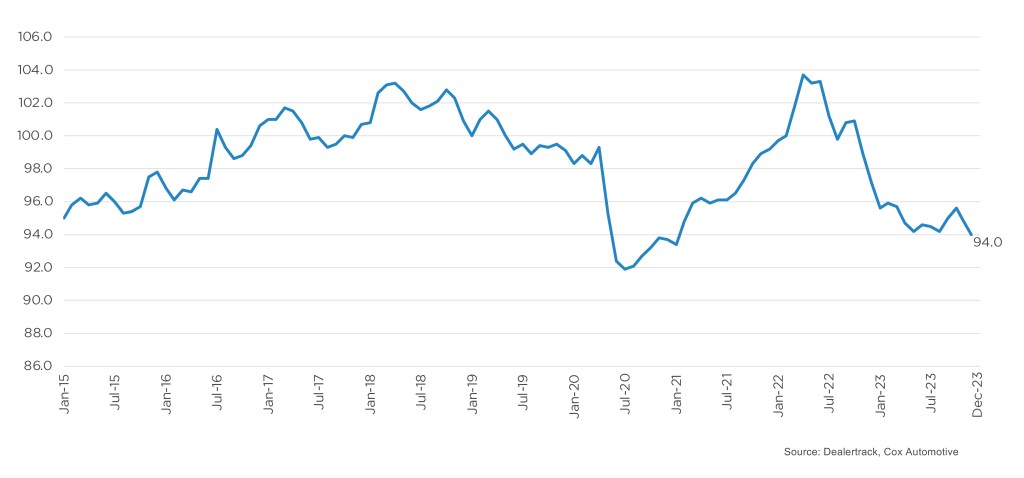Data Point
Auto Credit Availability Worsened Again in December
Tuesday January 16, 2024
Article Highlights
- According to the Dealertrack Auto Credit Availability Index for all types of auto loans, access to auto credit worsened in November.
- Following loosening across all channels and all lender types for most of the fall months, credit access is expected to tighten across all channels and most lender types, except for captives, as fall ends.
- The All-Loans Index decreased by 0.8% to 94.8 in November.
Access to auto credit declined in December as credit tightened across most channels and across all lender types, according to the Dealertrack Auto Credit Availability Index. The All-Loans Index declined in November and dropped another 0.9% to 94.0 in December, reaching its lowest level since May and erasing improvements made in the summer and fall. Credit access in all channels and lender types ended 2023 tighter than a year ago. Compared to February 2020, credit access was tighter in all channels except for used sales through independent dealers and for loans from auto finance companies.
Dealertrack Credit Availability Index1
Auto loan access worsened in December and was down year over year
All Auto Loans Index (Jan2019=100)

Most December Credit Availability Factors Moved Against Consumers
Movement in credit availability factors mostly moved against consumers in December. Yield spreads widened, term length declined, and the negative equity share declined, and those moves reduced credit access for consumers. Increases in the approval rate and the subprime share represented the only improvements for consumers. The down payment share was unchanged but at the highest level in the history of the data series. By channel, certified pre-owned (CPO) loans saw the most tightening, while new loans in total through independent used dealers saw the only loosening. On a year-over-year basis, all channels were tighter, with used loans through franchise dealers having seen the most tightening. Among lenders, credit unions tightened the most and were the tightest year over year.
The average yield spread on auto loans in December widened by 28 Basis Points (BPs), so rates consumers saw on auto loans were less attractive in December relative to bond yields. The average auto loan rate decreased by 20 (BPs) in December compared to October, while the 5-year U.S. Treasury increased by 48 BPs, resulting in a wider average observed yield spread.
The approval rate increased by 4 BPs in December and was down 0.7 percentage points year over year. The subprime share decreased to 11.5% from 11.2% in December and was down 0.9 percentage points year over year.
The share of loans with greater than 72-month terms decreased by 5 BPs and was down 1.5 percentage points year over year.
Most channels saw declining credit availability in December. Independent used loans saw the only expansion in credit access during the month, while new non-captive loans saw the most tightening. On a year-over-year basis, all channels were tighter, with used franchised loans having seen the most tightening.
Credit Availability Declined Across All Lender Types in December
Credit availability also declined in December across all lender types. Auto-focused finance companies saw the least tightening, while credit unions tightened the most. On a year-over-year basis, credit access was tighter across all lender types, with auto-focused finance companies tightening the least while credit unions tightening the most.
Each Dealertrack Auto Credit Index tracks shifts in loan approval rates, subprime share, yield spreads and loan details, including term length, negative equity, and down payments. The index is baselined to January 2019 to show how credit access shifts over time.
Measures of Consumer Confidence Saw Strong Improvement in December
The Conference Board Consumer Confidence Index® increased by 9.6% in December, as views of the present situation and future expectations both improved strongly. Consumer confidence was up 1.6% year over year. Plans to purchase a vehicle in the next six months increased and was up year over year. Consumer sentiment also improved in December, according to the sentiment index from the University of Michigan. The Michigan index increased 13.7% for the month and was up 16.6% year over year. Consumer expectations for inflation declined, with median expectations for inflation over the next year at the lowest level since March 2021. Buying conditions for vehicles increased and was up year over year. The daily index of consumer sentiment from Morning Consult improved 5.6% in December to end up 10.8% year over year. Gas prices declined further in December. According to AAA, the national average price for unleaded gas fell 4.2% to $3.11 per gallon as of Dec. 31, down 3% year over year and near the lowest average price in June 2021.
The Dealertrack Credit Availability Index is a monthly index based on Dealertrack credit application data and will indicate whether access to auto loan credit is improving or worsening. The index will be published around the 10th of each month.
1 In November 2023, the data behind the Dealertrack Auto Credit Availability Index was reset by our data sciences team as part of a migration to a new data management system. All points in the data set were reestablished, with January 2019 in the index set at 100 (as it had been previously). The All-Loans Index plot used in this post utilizes the new data set. The absolute numbers have shifted, but the trends and narrative have not. For more information, contact the Cox Automotive team.
Jonathan Gregory
Jonathan Gregory is a Senior Manager on Cox Automotive’s economic and industry insights team, which works to find actionable insights for the industry posed by Cox Automotive clients. Jonathan works with the Sales, Finance, and Data Science organizations and creates innovative solutions often combining proprietary data from other Cox Automotive brands. Jonathan joined Cox Automotive in 2022.

